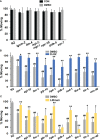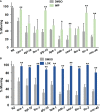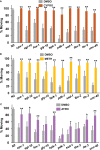Evolutionary conservation of putative suicidality-related risk genes that produce diminished motivation corrected by clozapine, lithium and antidepressants
- PMID: 38362034
- PMCID: PMC10867104
- DOI: 10.3389/fpsyt.2024.1341735
Evolutionary conservation of putative suicidality-related risk genes that produce diminished motivation corrected by clozapine, lithium and antidepressants
Abstract
Background: Genome wide association studies (GWAS) and candidate gene analyses have identified genetic variants and genes that may increase the risk for suicidal thoughts and behaviors (STBs). Important unresolved issues surround these tentative risk variants such as the characteristics of the associated genes and how they might elicit STBs.
Methods: Putative suicidality-related risk genes (PSRGs) were identified by comprehensive literature search and were characterized with respect to evolutionary conservation, participation in gene interaction networks and associated phenotypes. Evolutionary conservation was established with database searches and BLASTP queries, whereas gene-gene interactions were ascertained with GeneMANIA. We then examined whether mutations in risk-gene counterparts in C. elegans produced a diminished motivation phenotype previously connected to suicide risk factors.
Results and conclusions: From the analysis, 105 risk-gene candidates were identified and found to be: 1) highly conserved during evolution, 2) enriched for essential genes, 3) involved in significant gene-gene interactions, and 4) associated with psychiatric disorders, metabolic disturbances and asthma/allergy. Evaluation of 17 mutant strains with loss-of-function/deletion mutations in PSRG orthologs revealed that 11 mutants showed significant evidence of diminished motivation that manifested as immobility in a foraging assay. Immobility was corrected in some or all of the mutants with clozapine, lithium and tricyclic antidepressant drugs. In addition, 5-HT2 receptor and muscarinic receptor antagonists restored goal-directed behavior in most or all of the mutants. These studies increase confidence in the validity of the PSRGs and provide initial clues about possible mechanisms that mediate STBs.
Keywords: C. elegans; antidepressants; clozapine; diminished motivation; lithium; suicide.
Copyright © 2024 Ajayi, Thomas, Nikolic, Henderson, Zaheri and Dwyer.
Conflict of interest statement
The authors declare that the research was conducted in the absence of any commercial or financial relationships that could be construed as a potential conflict of interest.
Figures





Similar articles
-
[Psychopharmaceuticals for treatment of suicidal patients and for suicide prevention].Nervenarzt. 2016 May;87(5):483-7. doi: 10.1007/s00115-016-0088-y. Nervenarzt. 2016. PMID: 26952239 Review. German.
-
Insulin Signaling Deficiency Produces Immobility in Caenorhabditis elegans That Models Diminished Motivation States in Man and Responds to Antidepressants.Mol Neuropsychiatry. 2017 Nov;3(2):97-107. doi: 10.1159/000478049. Epub 2017 Sep 21. Mol Neuropsychiatry. 2017. PMID: 29230398 Free PMC article.
-
Candidate risk genes for bipolar disorder are highly conserved during evolution and highly interconnected.Bipolar Disord. 2021 Jun;23(4):400-408. doi: 10.1111/bdi.12996. Epub 2020 Oct 13. Bipolar Disord. 2021. PMID: 32959503
-
Precision medicine for suicidality: from universality to subtypes and personalization.Mol Psychiatry. 2017 Sep;22(9):1250-1273. doi: 10.1038/mp.2017.128. Epub 2017 Aug 15. Mol Psychiatry. 2017. PMID: 28809398 Free PMC article.
-
Catalytic Reaction Model of Suicide.Front Psychiatry. 2022 Mar 9;13:817224. doi: 10.3389/fpsyt.2022.817224. eCollection 2022. Front Psychiatry. 2022. PMID: 35356712 Free PMC article. Review.
Cited by
-
Converging evidence for functional connections between the lithium response and PI3K-Akt signaling.Transl Psychiatry. 2024 Nov 1;14(1):458. doi: 10.1038/s41398-024-03160-y. Transl Psychiatry. 2024. PMID: 39487122 Free PMC article. No abstract available.
References
-
- World Health Organization . (2021), in: November 11, 2021. Available at: https://www.who.int/news-room/fact-sheets/detail/suicide.
LinkOut - more resources
Full Text Sources
Research Materials

